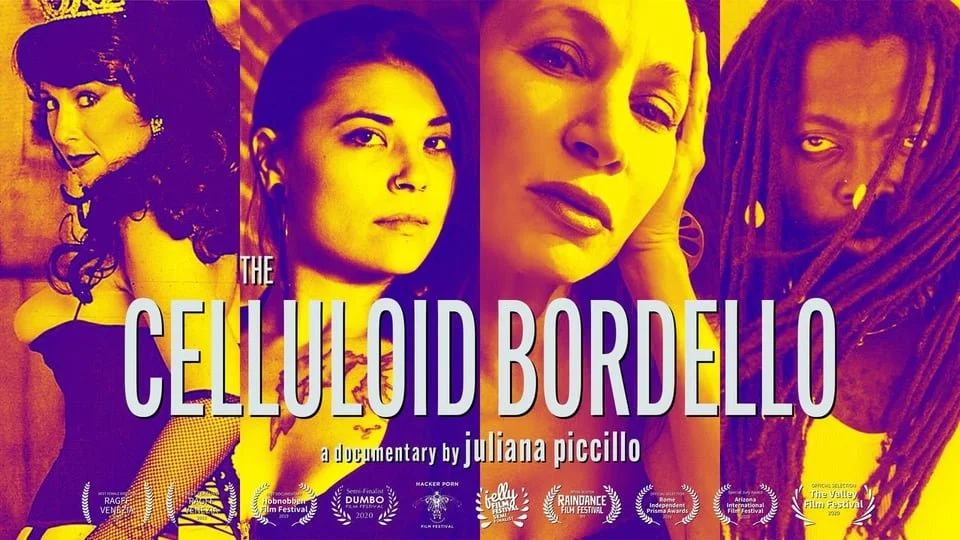THE CELLULOID BORDELLO traces the history of sex work on screen
The Celluloid Bordello
Directed by Juliana Piccillo
Starring: Annie Sprinkle, Nicholas de Villiers and Peter Keough
Unrated
Runtime: 1 hour, 26 minutes
Available digitally on Amazon, Apple TV, and iTunes January 10
by Gary M. Kramer, Staff Writer
Movies have long portrayed sex workers as characters who range from “disposable” victims to “hookers with hearts of gold.” But what messages are films like Pretty Baby (1978) and Pretty Woman (1990) providing viewers about “the oldest profession?” Director Juliana Piccillo investigates how films present sex workers in her interesting documentary that features several real-life sex workers discussing what screen characters and images have influenced them positively and negatively.
The Celluloid Bordello contains clips from more than fifty films that feature sex workers, from pre-code films such as Pandora’s Box (1929) and Rain (1932) to films made during the Hays code such as Waterloo Bridge (1940), Gypsy (1962), and Irma La Douce (1963) to post-code films that became more frank in their depictions of sex work, starting with Midnight Cowboy (1968).
The point Piccillo is making—aided by commentary from various talking heads including sex worker Annie Sprinkle, academic Nicholas de Villiers, and film critic Peter Keough is that sex workers are often misrepresented on screen or portrayed in ways that dehumanize these characters or fail to elicit compassion. Examples of sex workers being beaten up in Leaving Las Vegas (1995), Monster (2003), or Mysterious Skin (2004) illustrate the trope that these films are “stories of desperation.” However, several subjects in the film, including Sprinkle, demystify this conception by saying that they were empowered by sex work.
How films shape our collective ideas about sex work is the most salient takeaway from the documentary. Many examples feature the clichés that women are passive and need saving (e.g., Sweet Charity, Pretty Woman) or want to exit sex work. In contrast, when men in films perform gay sex work, it is either as a last resort in films such as Sonny (2002) or they are processing oedipal trauma, as seen in Midnight Cowboy and My Own Private Idaho (1991). These keen insights explain why sex work is repeatedly used as the subject for (melo)dramas and the fantasies that they portray.
Attitudes about sex work often prompt the question, “How can you do this?” The Celluloid Bordello includes a clip from Irma La Douce in which the title character, played by Shirley MacLaine, recounts a trauma that prompts a client to tip her more generously, something Piccillo, a sex worker and activist, says that she has done herself. When several of the interviewees discuss their own experiences as sex workers, the documentary provides some understanding of the profession and how these viewers relate to and process the images that they see reflected back at them.
The Celluloid Bordello also discusses the idea that sex work is glamorous or that sex workers have agency. Trading Places (1983) has an inspiring and financially savvy sex worker played by Jamie Lee Curtis, while Pretty Baby shows the comforting “family” atmosphere of a brothel. In contrast, The Best Little Whorehouse in Texas (1982) is a sanitized portrayal of sex work, and a more important example of how a sex worker (Dolly Parton as Miss Mona) will sacrifice her love and happiness because her profession jeopardizes the dreams of her lover, Sheriff Ed Earl Dodd (Burt Reynolds).
The Celluloid Bordello also makes the case that playing a sex worker can often lead to winning an Oscar through a montage that shows dozens of films such as Gigi (1958) and Midnight Cowboy and actors, including Janet Gaynor in Street Angel (1928), Elizabeth Taylor in Butterfield 8 (1960), Jane Fonda in Klute (1971), and Mira Sorvino in Mighty Aphrodite (1995), being thusly honored. However, one Oscar-winning film, the documentary Born into Brothels (2004), about children of sex workers in Sonagchi, Calcutta, is critiqued for being less accurate about its topic than the filmmakers depict.
The discussion of sex trafficking in film is all too briefly addressed in the documentary, with a small scene about Trade (2007) and other films that depict this horrific practice. This scene suggests that Piccillo could have unpacked more about the topic but focused on the points that she wants to make. Overall, the film can feel repetitive or slight or miss prime opportunities; Taxi Driver (1976) and American Gigolo (1980) are barely addressed. Meanwhile, a clip from The Hangover Part II (2011) that shows a transgender sex worker being played for laughs/disgust scratches the surface of how sex workers are often the butt of jokes.
The Celluloid Bordello ends with a consideration of Pretty Woman, a romantic fantasy featuring a character who performs sex work. Vivian (Julia Roberts) is treated like a child in order to be improved and reformed. Piccillo contrasts Pretty Woman with Tangerine (2015), a funny and authentic portrayal of two trans sex workers of color who accept who they are and the value that they receive for work that they do; Tangerine is applauded by several of the interviewees in the documentary.
Piccillo provides a stimulating discussion of the topic. If her filmmaking is a bit crude, her messages come across clearly.


